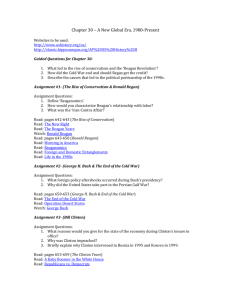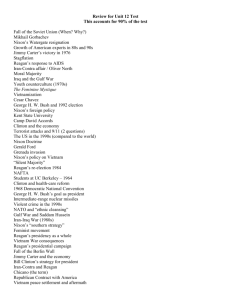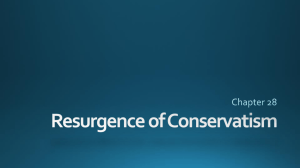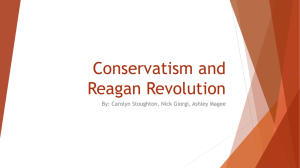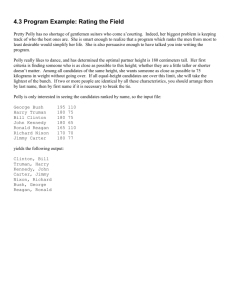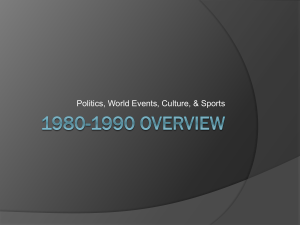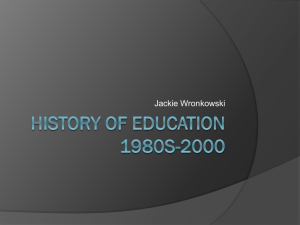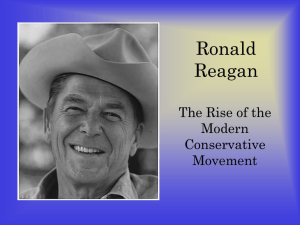Lecture Chapter 31, Transitional America
advertisement
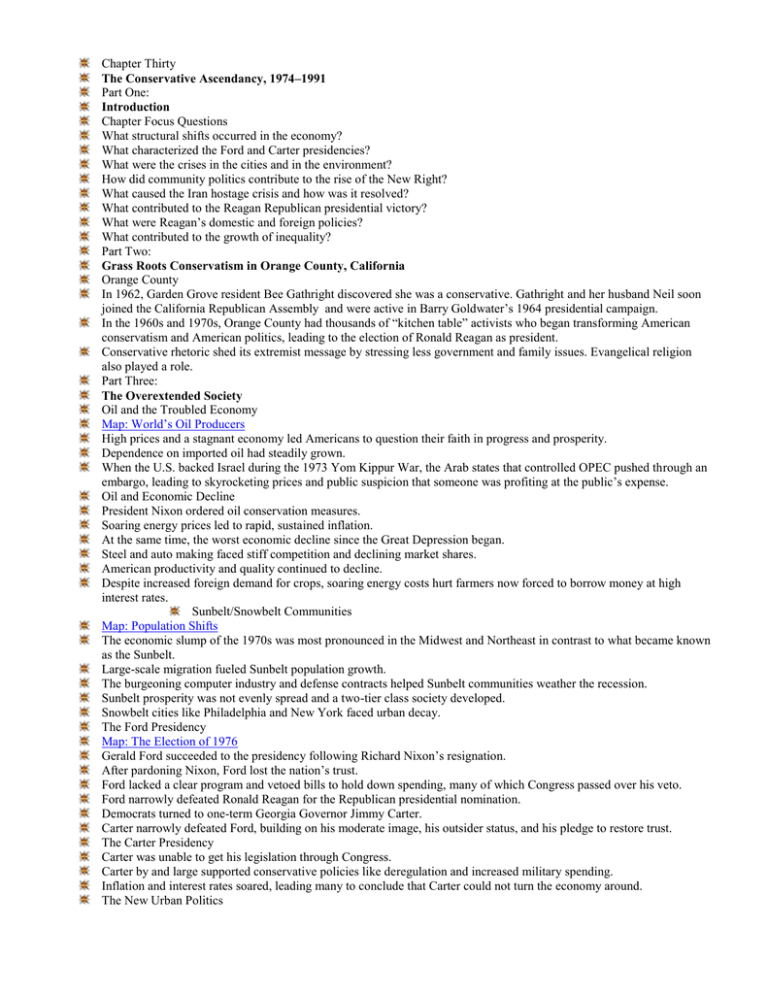
Chapter Thirty The Conservative Ascendancy, 1974–1991 Part One: Introduction Chapter Focus Questions What structural shifts occurred in the economy? What characterized the Ford and Carter presidencies? What were the crises in the cities and in the environment? How did community politics contribute to the rise of the New Right? What caused the Iran hostage crisis and how was it resolved? What contributed to the Reagan Republican presidential victory? What were Reagan’s domestic and foreign policies? What contributed to the growth of inequality? Part Two: Grass Roots Conservatism in Orange County, California Orange County In 1962, Garden Grove resident Bee Gathright discovered she was a conservative. Gathright and her husband Neil soon joined the California Republican Assembly and were active in Barry Goldwater’s 1964 presidential campaign. In the 1960s and 1970s, Orange County had thousands of “kitchen table” activists who began transforming American conservatism and American politics, leading to the election of Ronald Reagan as president. Conservative rhetoric shed its extremist message by stressing less government and family issues. Evangelical religion also played a role. Part Three: The Overextended Society Oil and the Troubled Economy Map: World’s Oil Producers High prices and a stagnant economy led Americans to question their faith in progress and prosperity. Dependence on imported oil had steadily grown. When the U.S. backed Israel during the 1973 Yom Kippur War, the Arab states that controlled OPEC pushed through an embargo, leading to skyrocketing prices and public suspicion that someone was profiting at the public’s expense. Oil and Economic Decline President Nixon ordered oil conservation measures. Soaring energy prices led to rapid, sustained inflation. At the same time, the worst economic decline since the Great Depression began. Steel and auto making faced stiff competition and declining market shares. American productivity and quality continued to decline. Despite increased foreign demand for crops, soaring energy costs hurt farmers now forced to borrow money at high interest rates. Sunbelt/Snowbelt Communities Map: Population Shifts The economic slump of the 1970s was most pronounced in the Midwest and Northeast in contrast to what became known as the Sunbelt. Large-scale migration fueled Sunbelt population growth. The burgeoning computer industry and defense contracts helped Sunbelt communities weather the recession. Sunbelt prosperity was not evenly spread and a two-tier class society developed. Snowbelt cities like Philadelphia and New York faced urban decay. The Ford Presidency Map: The Election of 1976 Gerald Ford succeeded to the presidency following Richard Nixon’s resignation. After pardoning Nixon, Ford lost the nation’s trust. Ford lacked a clear program and vetoed bills to hold down spending, many of which Congress passed over his veto. Ford narrowly defeated Ronald Reagan for the Republican presidential nomination. Democrats turned to one-term Georgia Governor Jimmy Carter. Carter narrowly defeated Ford, building on his moderate image, his outsider status, and his pledge to restore trust. The Carter Presidency Carter was unable to get his legislation through Congress. Carter by and large supported conservative policies like deregulation and increased military spending. Inflation and interest rates soared, leading many to conclude that Carter could not turn the economy around. The New Urban Politics Political mobilization during the 1970s frequently focused on community issues that cut across ideological lines. College students, along with African Americans and other minorities, mobilized and won power in numerous communities. Several major cities elected black mayors. The fiscal crisis of the 1970s frequently foiled their plans for reforms. The Endangered Environment The roots of the environmental movement dated back to the works of Rachel Carson in the early 1960s. Twenty million Americans participated in the first Earth Day. The Three Mile Island incident and the linking of cancer at Love Canal to toxic waste raised U.S. concern over pollution. Growing interest in the concept of ecology led Americans to lobby for renewable energy sources, protecting endangered species, and reducing pollution. Despite public outcries, government officials frequently responded to other pressures. Part Four: The New Conservatism The New Right A variety of forces converged to turn back the great society and form the New Right: conservative centers like the Heritage Foundation paramilitary groups religious conservatives who supplied the strongest boost The New Right promoted its agenda through televangelists. New Right politicians like Jesse Helms amassed huge campaign chests. Anti-ERA and Anti-Abortion The New Right successfully blocked ratification of the ERA and rallied support for efforts to make abortions illegal. Gallup Poll: Abortion The “Me Decade” Critics characterized the 1970s as a decade when Americans: abandoned political change focused on personal well-being fostered a “culture of narcissism” During the 1970s, a wide range of personal-growth techniques flourished among the middle class. Religious cults grew. Popular music became increasingly despairing and nihilistic, nostalgic, or decadent. Part Five: Adjusting to a New World A Thaw in the Cold War Presidents Ford and Carter both believed that American power had been declining and that there should be no more Vietnams. High levels of military spending had hurt the American ability to compete effectively with economic rivals. American diplomats sought a way to wind down the cold war by getting the Soviets to agree to respect human rights and by negotiating arms control agreements. Foreign Policy and Moral Principles Jimmy Carter pledged to put human rights at the center of his foreign policy. Though speaking out about violations in some nations, he overlooked others in areas vital to U.S. interests. His greatest success came when he negotiated the Camp David Accord between Egypt and Israel, though the agreement did not bring stability to the region. Carter reformed the CIA and returning the Canal Zone to Panama. (Mis)Handling the Unexpected Carter received contradictory advice urging him to be both tough on and conciliatory toward the Soviets. His Third World efforts received mixed support for both authoritarian and revolutionary governments. He urged Americans to put aside their “inordinate fear of communism,” but reacted strongly to a Soviet intervention in Afghanistan. The Iran Hostage Crisis Carter’s decision to allow the deposed shah of Iran to enter the country for medical treatment backfired. Iranian students seized the American embassy and held its personnel hostage. He tried diplomacy and at the same time an ill-fated rescue operation. Both failed. The Election of 1980 Map: The Election of 1980 When his programs failed to stimulate the economy, Carter claimed that the nation was experiencing a crisis of confidence. The plan backfired and voters lost respect for him. As the election of 1980 approached, an unenthusiastic Democratic convention endorsed him. The Republicans nominated Ronald Reagan, who asked voters, “Are you better off now than you were four years ago?” Reagan won 50.9 percent of the vote but an overwhelming majority in the electoral college. Part Six: The Reagan Revolution The Great Communicator Ronald Reagan tried to reshape the political landscape of the nation. Reagan’s program aimed to stimulate the economy by: cutting government spending government deregulation cutting taxes for the wealthy He appointed conservatives to head agencies like the EPA that abolished or weakened rules protecting the environment and workplace safety. Reagan called for a massive military buildup. Reaganomics Reaganomics is based a supply-side economic theory: Essentially, a successful economy depended upon the proliferation of the rich The Economic Recovery Tax Act of 1981: the largest tax cut in the nation’s history The Omnibus Reconciliation Act of 1981: a comprehensive program of federal spending cuts While decreasing spending on domestic programs, Reagan greatly increased defense budget The Election of 1984 In the 1984 election, Walter Mondale won the Democratic nomination by concentrating on the traditional Democratic constituencies. Reagan countered Mondale’s criticisms by claiming that the nation was strong, united, and prosperous. Reagan won in one of history’s biggest landslides. Recession, Recovery, Fiscal Crisis A recession gripped the economy during the early 1980s. By the mid-1980s the economy grew and inflation was under control. Critics claimed the growth resulted from increased military spending. The economic recovery was unevenly spread; most new jobs did not pay enough to support a family. Enormous budget deficits grew to an unprecedented $2 trillion as the U.S. became the world’s leading debtor. The fiscal crisis was made worse by scandals in securities industry. In 1987, the stock market crashed, ending the bull market of the 1980s. Part Seven: Best of Times, Worst of Times The Celebration of Wealth While the 1980s celebrated wealth and moneymaking, the gap between rich and poor widened. The middle class also declined. A Two-Tiered Society During the 1980s, the average weekly earnings declined substantially. Half the new jobs did not pay enough to keep a family out of poverty. Race sharply defined the gap between rich and poor. Feminization of Poverty Women experienced declining earning power during this period. Divorce contributed significantly to female poverty—new no-fault divorce laws. A sharp rise in teenage pregnancy also contributed. Political mobilization for protecting the rights of poor women was at a low ebb. Epidemics: Drugs, AIDS, Homelessness The 1980s saw new epidemics erupt. “Yuppie” cocaine and inner-city crack use spiraled, unleashing a crime wave. The Reagan administration declared a war on drugs, but concentrated its resources on the overseas supply and did little to control demand at home. In 1981, doctors identified a puzzling disease initially found among gay men—AIDS. An epidemic of homelessness grew during the decade. One-third were mental patients discharged from psychiatric hospitals. Part Eight: Reagan’s Foreign Policy The Evil Empire Reagan made anti-communism the centerpiece of his foreign policy, calling the Soviet Union an “evil empire.” Despite American superiority, Reagan pushed to enlarge the nuclear strike force. He called for a space-based “Star Wars” missile defense system that many saw as an effort to achieve a first-strike capability. Attempts at meaningful arms control stalled. The Reagan Doctrine and Central America Map: The U.S. in Central America The Reagan Doctrine pursued anti-communist activity in Central America. Reagan’s “Caribbean Basin Initiative” to stimulate economic growth tied the region’s economy closer to American corporations. Reagan intervened in Grenada, E1 Salvador, and waged a covert war against the revolutionary government of Nicaragua. The Iran-Contra Scandal In 1986, news broke of how the United States traded arms to Iran in return for their assistance in freeing hostages held by terrorist groups. The money from the arms sales was used to fund the Contras in Nicaragua. Oliver North, who ran the enterprise, acknowledged that he had told a web of lies and destroyed evidence, all in the name of patriotism. An investigating commission concluded that Reagan had allowed a small, unsupervised group to run the operation. In 1992, outgoing President George Bush, whose involvement had been the target of much speculation, pardoned several officials who were scheduled to be tried. The United States in the Middle East Map: The United States in the Middle East The volatility of the Middle East influenced U. S. foreign policy. The Collapse of Communism In 1985, Mikhail Gorbachev came to power in the Soviet Union and instituted a series of political and economic reforms. Under his glasnost and perestroika campaigns, Gorbachev took the lead in negotiating an end to the arms race to allow economic growth to take place. Treaties were finally worked out that called for destruction of some missiles and allowed for on-site inspections. Although the Soviet Union no longer posed the threat it once had seemed to pose, the cold war mentality did not disappear. Part Nine: Conclusion The Conservative Ascendancy, 1974–1987 Media: Chronology Chapter Thirty-One Toward a Transnational America, since 1988 Part One: Introduction Chapter Focus Questions What was American foreign policy like after the cold war? What was the impact of the new economy and the boom of the 1990s? What revelations resulted from the 2000 Census? What characterized the Clinton presidency and resurgent conservatism? What was globalization? How did international terrorism affect the United States? Part Two: The World Trade Center, New York as a Transnational Community World Trade Center, New York In August 2001, Telmo Alvear became a waiter at the Windows on the World restaurant located in the North Tower of the World Trade Center (WTC) in New York City. The restaurant was part of the transnational community created by the more than 50,000 people who work at the World Trade Center. Many of the firms renting space in the twin towers were multinational operations from Latin America, Asia, Africa, and Europe. The WTC symbolized American leadership and the belief that transnationalism would lay the foundation for a new world order based on democratic liberalism. Part Three: “A Kinder, Gentler Nation” The Persian Gulf War When Iraq invaded Kuwait in 1990, President Bush formed a coalition: to prevent Iraqi aggression against Saudi Arabia. to enforce economic sanctions against Iraq. Bush shifted policies and prepared for an offensive war to drive out Iraq. The U.S. relentlessly bombed Iraq, driving it from Kuwait. The war left Iraq devastated and, although Saddam Hussein remained in power, wreaked ecological havoc in the region. Mideast tensions worsened due to the conflict between Israel and the Palestinians. A Saudi millionaire built the Al Qaeda terrorist network. The Election of 1992 A harsh recession and soaring national debt had eroded public confidence in the Bush administration. Democrats turned to centrist governor Bill Clinton of Arkansas, who stressed the need for fiscal responsibility, a middleclass tax cut and new jobs. Billionaire H. Ross Perot won support for his independent bid with his folksy style and criticism of Washington insiders. Clinton focused on the “forgotten middle class” in an effort to return Reagan Democrats to the fold. Clinton won 43 percent of the vote to Bush’s 38 percent and Perot’s 19 percent. Map: The Election of 1992 Part Four: The Clinton Presidency A “New Democrat” in the White House Clinton broke political gridlock by positioning himself between warring Democrats and Republicans. Often backing ideas friendly to Republicans, he clashed with liberal Democrats. Clinton unsuccessfully promoted a plan for national health insurance: Clinton pushed through a series of trade agreements (NAFTA and GATT), which raised fears that jobs were being sent abroad while environmental standards were being weakened at home. Clinton’s Internationalism Transnational human rights emerged as another issue. Human rights became factors in trade and diplomatic relations (i.e.: China). International organizations were formed to work with the United Nations to aid victims of abuses. Clinton connected human rights to the expansion of democracy. Heightened ethnic nationalism and religious fundamentalism created unrest across the globe, especially in the Balkans. The civil war in Kosovo between the Serbians and Albanians was the worst foreign crisis of Clinton’s presidency. After negotiations failed, NATO bombed Serbian forces that eventually withdrew from Kosovo. Their president was indicted on war crimes. Presiding over the Boom The greatest stimulus to the economy was the soaring stock market, led by “tech” stocks. The resulting economic boom created huge profits. Critics noted the ill effects of downsizing and the pay disparity between white- and blue-collar workers plus the continuing decline of blue-collar jobs. Part Five Changing American Communities Silicon Valley Silicon Valley in northern California emerged as the capital of the American computer industry. Although Silicon Valley resembled a suburb, it was a sprawl of two dozen cities that expanded rapidly as the computer industry grew. Silicon Valley divided along class lines: the white male managers and engineers lived in affluent communities. non-unionized, Latino, and Asian workers lived in poor communities. By the early 1990s, the Silicon Valley had lost its boomtown atmosphere as competition increased. An Electronic Culture Map: Cyberspace New computer and telecommunications technologies transformed American cultural life. VCRs and cable TV revolutionized the American entertainment industry. Music videos on MTV transformed the music business. The most revolutionary aspect of the electronic culture was the Internet. The new information technologies gave rise to a media community that transcended national boundaries, but the ownership of media corporations became increasingly concentrated. The New Immigrants and Their Communities Media: Continent of Birth The 2000 census showed that the U.S, population had experienced greater growth than any other decade. More than one-third of the population increase came from foreign immigration, the Latino and Asian populations increasing by 70 percent. Most Mexican immigrants struggled in low-paying, often dangerous jobs. Another trend was intermarriage and a growing number of multiracial Americans. Hispanics were the largest minority group among those 17 and younger. Immigrants formed their own communities and maintained their group identity. Part Six: A New Age of Anxiety The Racial Divide In the spring of 1992, rioting broke out when a jury acquitted four Los Angeles police officers who had been videotaped beating a black motorist. Rioters included Latino and African Americans. The rioting revealed the animosity between Korean storeowners and African-American customers who targeted the stores for destruction. For many African Americans, the Los Angeles situation seemed more desperate than ever and whites seemed not to care at all. The widening racial divide was also shown by the trial of O.J. Simpson and the percentage of racial minorities in prisons, especially African-American males. The Forces of Fear During the 1990s and early twenty-first century, random violence and terrorism escalated, culminating with the catastrophic September 11, 2001, suicide attacks. The 1988 bombing of a Pan Am plane was followed by the 1993 attack on the World Trade Center, which brought terrorism home to the United States. In 1998, Middle East terrorists car-bombed U.S. embassies in Africa. The 1995 bombing in Oklahoma City was different in that domestic terrorists were responsible. The Culture Wars Culture wars erupted over a struggle to define American values that pit conservative Republicans and Clinton Democrats. Conservatives supported what they called universal, traditional values. Democrats supported multiculturalism. Conflicts also arose over affirmative action, gays, and women. A growing controversy arose over stem-cell research. High Crimes and Misdemeanors Throughout his political career, Bill Clinton faced questions of morality. The culture wars heated up as the 1994 election approached. Led by Newt Gingrich, a new breed of younger conservative Republicans swept the Congressional elections of 1994. Republicans promoted a “Contract with America” to cut welfare and eliminate affirmative action. Failure to compromise on a budget in 1995 shut the government down and proved a public relations disaster for the GOP. High Crimes and Misdemeanors Bill Clinton proved adept at co-opting Republican issues such as ending big government and balancing the budget. In the 1996 presidential election, Clinton projected a reasonable, conservative image and portrayed Republicans as conservative radicals. Clinton easily beat GOP candidate Bob Dole and independent Ross Perot. In 1998, a sex scandal embroiled the White House, leading to impeachment inquiries. The midterm election resulted in Democratic gains, due in part to the economic prosperity. The Republican House voted to impeach Clinton for perjury and obstruction of justice but failed to convict him. Part Seven: The New Millennium The Election of 2000 Map: The Election of 2000 Following a dull campaign, the 2000 election ended with dramatic controversy. Al Gore won the popular vote, but George W. Bush won the electoral vote because of a disputed decision in Florida that eventually involved a Supreme Court ruling. Bush pushed through a tax cut that benefited the wealthy. Bush also moved quickly to reverse environmental decisions made by Clinton. Global Warming Bush opposed the Kyoto Protocol on global warming that had been signed by 178 other nations. Globalization was studied for its economic and political implications. Globalization’s role in the spread of free trade and democracy was debated. Part Eight War On Terror Terrorist Attack on America On September 11, 2001, hijackers crashed two jetliners into the World Trade Center towers and another crashed into the Pentagon. A fourth plane was diverted from its mission by courageous passengers and crashed in Pennsylvania. The devastation was horrendous and played continuously on TV. President Bush declared the attacks an act of war and received congressional approval to take whatever action necessary to capture the responsible parties. In the aftermath, major public events were cancelled or postponed, skyscrapers were evacuated, and airports were closed. The following day, Osama bin Laden and Al Qaeda were identified as the prime suspects. Reshaping U.S. Foreign Policy Osama bin Laden was thought to be hiding in Afghanistan and supported by the Taliban government. Bush dispatched aircraft carriers to the Persian Gulf and began air strikes on Afghanistan. Part Nine: Conclusion Toward a Transnational America Media: Chronology
